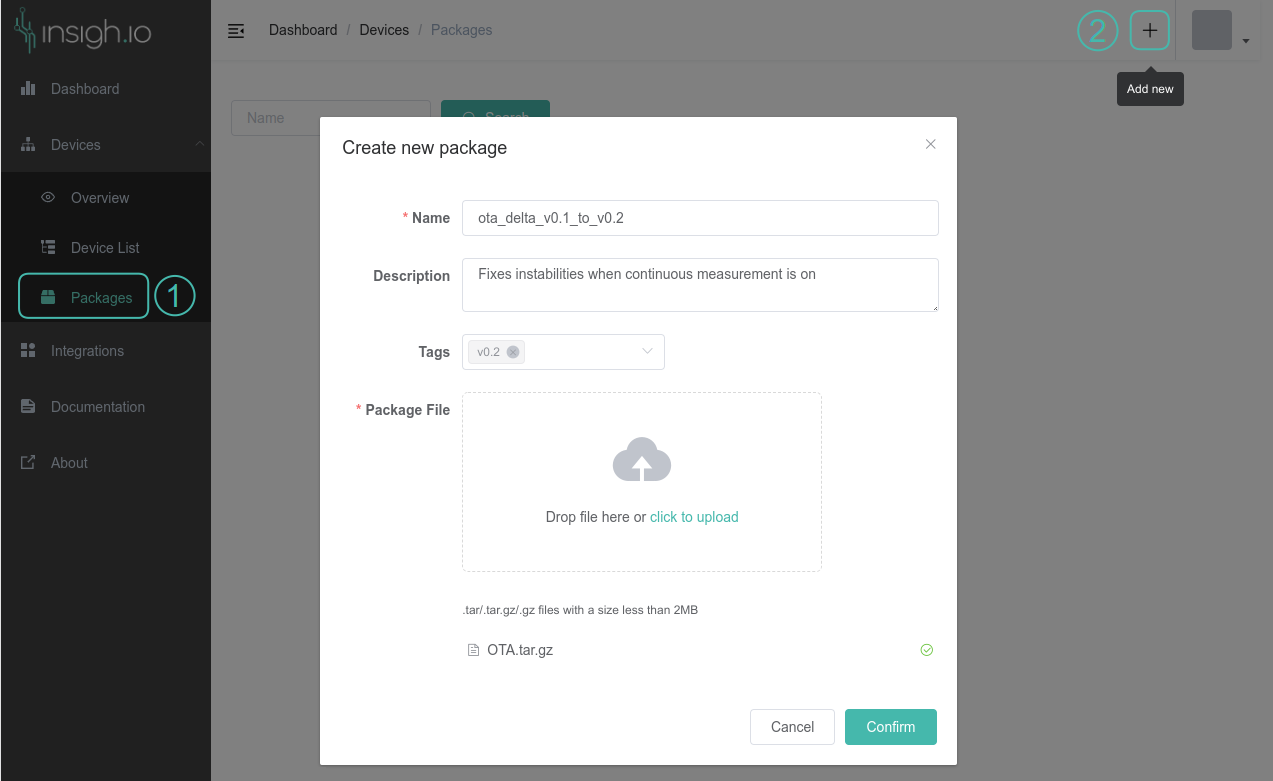Packages
The console.insigh.io platform, when combined with the insigh.io firmware offers a build-in mechanism for Over-The-Air updates.
The implemented mechanism is a secure file sharing combined with status reports on procedure status.
Generic Operation of OTA in console.insigh.io
To begin with, let’s consider having a file OTA.tar.gz that contains the OTA data, which is needed to be transferred to the device as soon as possible. The contents of the file will be described at the end of this article with an example for how insigh.io firmware handles OTA udpates.
Navigate to Devices -> Packages and create a new Package by providing its name, description info, tags and the file to be shared.

Upon successful creation, the package, is ready to be assigned to the device through the Device Info view, or through batch operation in Device List.
By requesting an OTA for one or more devices through the OTA widget, the following internal procedure occurs:
- A retained MQTT message is published on the Control Channel in subtopic ota :
- topic example:
channels/1422987b-930b-4fc3-a185-6cdff6f855ac/messages/eb39752e-99ca-4028-add9-23ec63d4d3ef/ota - message example:
[{"n":"e","v":0},{"n":"i","vs":"7985d8c2"},{"n":"t","vs":".tar.gz"},{"n":"s","v":3987}]- an event type of “pending”
- the file id to be retrieved
- the file type extension
- the file size
- topic example:
- The device, during its run, will subscribe to the control channel. Since the message is retained, the message will be delivered to the device immediately after its subscription.
- The device is responsible to execute checks for available space etc. based one the data received.
- The device downloads the package over HTTPS using device ID/Key, Control Channel ID, and the File ID received from the OTA request. The device ID/Key are validated with Channel ID to confirm the legitimate access to the file.
- HTTPS request:
https://console.insigh.io/mf-rproxy/packages/download?fuid=<file-id>&did=<device-id>&dk=<device-key>&cid=<control-channel-id> - example using the device details from Device Creation with ID:
0d129ed0-0109-4ead-97da-43302a758eed, Key:e9e8350e-953b-460a-bbbc-84fcc7c07608, Control Channel:3573ea18-7c79-4748-92b6-69776a5ed20fhttps://console.insigh.io/mf-rproxy/packages/download?fuid=7985d8c2&did=0d129ed0-0109-4ead-97da-43302a758eed&dk=e9e8350e-953b-460a-bbbc-84fcc7c07608&cid=3573ea18-7c79-4748-92b6-69776a5ed20f
- HTTPS request:
- The package is downloaded, is applied and then the device is responsible to report back the installation status by following the procedure:
- clear the retain message from the aforementioned topic
- publish a non-retained message to the same topic which will contain:
- e: an event id named with value
- 1 if the OTA has been applied successfully
- 2 if the OTA has failed
- i: the file id
- m: an optional message. mainly using when OTA fails to state the reason of failure.
- example:
- successful:
[{"n":"e","v":1},{"n":"i","vs":"7985d8c2"}] - failed:
[{"n":"e","v":2},{"n":"i","vs":"7985d8c2"},{"m":"i","vs":"not enough space"}]
- successful:
- e: an event id named with value
How to create OTA package for devices running insigh.io firmware
insigh.io firmware is based on micropython. So, the firmware is composed with the micropython subsystem combined with the .py files of each project that are uploaded in the device’s flash (path: “/").
In 99% of the cases, the micropython subsystem remains the same and the only fixes/ upgrades that take place relate with the .py project files. For this reason, the OTA packages that are currently in use are .tar files that pack the files to be transferred into one file. The firmware is able to handle the .tar files by extracting the files in the corresponding folders, reporting the OTA status back to the console.insigh.io and resets to start running with the updated changes.
To automate the OTA package creation, insigh.io provides a tool that handles the TAR file creation, file filtering and Python file minification. The tool is microfreezer and it is used internally by insigh.io to both generate OTA packages and to prepare the firmware binaries provided in the releases of insighioNode project.
As an example, consider having checked out the insighioNode firmware in folder “~/projects/insighioNode”. All files/folders from path ~/projects/insighioNode/insighioNode/ are copied as is in the device root flash folder “/”. From this project 2 files have changed with the desired fixes:
- ~/projects/insighioNode/insighioNode/apps/demo_console/demo_scenario.py
- ~/projects/insighioNode/insighioNode/apps/demo_console/demo_utils.py
So, it is required to send the above 2 files to the device. The important part here is to keep the folder structure. Follows the commands on how to copy files and generate the OTA package:
mkdir -p /tmp/otaPackage/src/apps/demo_console
mkdir -p /tmp/otaPackage/firmware
cp ~/projects/insighioNode/insighioNode/apps/demo_console/demo_scenario.py /tmp/otaPackage/src/apps/demo_console/demo_scenario.py
cp ~/projects/insighioNode/insighioNode/apps/demo_console/demo_utils.py /tmp/otaPackage/src/apps/demo_console/demo_utils.py
# assuming microfreezer is checked out in the following path
cd ~/projects/microfreezer
# check config.json for desired config. recommended:
# {
# "excludeList": [
# "README",
# "README.md",
# "LICENSE",
# ".git",
# ".gitmodules",
# "examples",
# "local_demos"],
# "directoriesKeptInFrozen": [""],
# "enableZlibCompression": false,
# "targetESP32": true,
# "targetPycom": false,
# "minify": true
# }
python3 microfreezer.py --ota-package /tmp/otaPackage/src/apps/demo_console /tmp/otaPackage/firmware
Upon successful completion, the OTA package has been generated in path /tmp/otaPackage/firmware and is ready to be updated and registered to the Packages page of console.insigh.io.